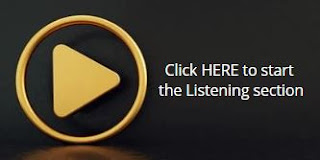Listening Section
In this section of the test, you will have the chance to show how well you understand spoken English. There are 4 parts to this section, with special directions for each part.Part I. Pictures
Questions: 1 to 3.Directions:
For each item, there is a picture in your test book and four short statements about it on the tape. These statements will be spoken twice, but are NOT WRITTEN out in your test book, so you must listen carefully. You must choose one statement – (A), (B), (C), or (D) – that best describes the picture. Then, on your answer sheet, mark your choice.
Example: Look at the picture and listen to the four sentences.
- The girl is wearing a T-shirt.
- The girl has curly hair.
- The girl looks unhappy.
- The girl is holding something.
Part II. Questions/Statements – Responses
Questions: 4 to 6Directions:In this part of the test, you will hear several questions spoken in English, followed by three responses, also spoken in English. The questions and responses will be spoken twice. They are not printed in your test book, so you must listen carefully to understand what the speakers say. You have to choose the best response to each question.
Now listen to a sample question. You will hear: “Where can I pick up my tickets?”.
You will also hear
- Thursday morning, if that’s convenient
- At the Overseas Travel Desk
- I think it’s at nine o’clock".
- Mark your answer on your answer sheet.
- Mark your answer on your answer sheet.
- Mark your answer on your answer sheet.
Part III. Short Conversations
Questions: 7 to 10Directions:In this part of the test, you will hear several short conversations. You will hear the conversations twice. The conversations are not printed in your test book, so you must listen carefully to understand what the speakers say. In your test book, you will read a question about each conversation. The question will be followed by four answers. You have to choose the best answer to each question and mark it on your answer sheet.
Example:
You will hear:
Man: "Are you a student here?"
Woman: "Yes, Sir."
Man: "Where is the English class?"
Woman: "Next to the laboratory."
You will read: "Where does the dialogue probably take place?"
- At the hospital.
- At the station.
- At the market.
- In a school.
- Why is the man later than usual?
- He missed the taxi.
- He rides his motorcycle.
- He gave his friend a ride.
- He is going by taxi.
-
What did the man choose to drink?
- Avocado juice.
- Apple juice.
- Orange juice.
- Soft drink.
-
What time should the man call again?
- After lunch.
- Before lunch.
- Now.
- Some time later.
-
What can be implied about the woman?
- She will go to the mountain with her classmates.
- She keeps the man’s photograph.
- She lives not far from the mountain.
- She will go to the mountain as soon as possible.
Part IV. Short Talks
Questions: 11 to 15Directions: In this part of the test, you will hear several short talks. Each will be spoken twice. They are not printed in your test book, so you must listen carefully to understand and remember what is said. In your test book, you will read two or more questions about each short talk. Each question will be followed by four answers. You have to choose the best answer to each question and mark it on your answer sheet.
- What is the talk about?
- How to take a plug out of a socket.
- How to switch off a tool
- How to fix a tool.
- How to operate a tool.
-
When should you release the button?
- After putting the plug into the socket.
- After placing the tip of the screwdriver.
- When the screw is strongly attached to its place.
- After taking the plug out of the socket.
-
Why would you put the plug into the socket?
- To place the screw on the tip of the screwdriver.
- To switch on the power button.
- To push the button while you install the screw.
- To release the button.
-
What is the final destination of the flight?
- Bangkok
- Copenhagen
- Dubai
- Calcutta
-
What will happen in a few minutes?
- The plane will take off.
- The passengers will board the plane.
- The gate number will be announced.
- The flight will land in Dubai.































